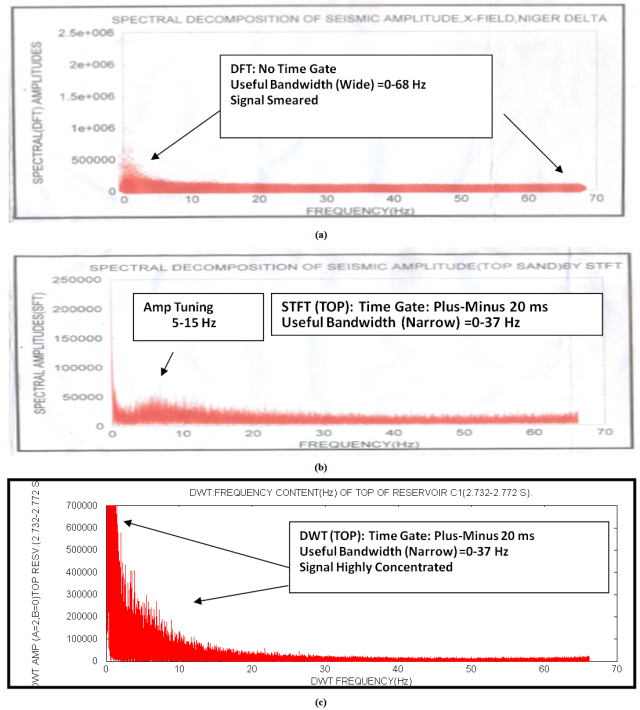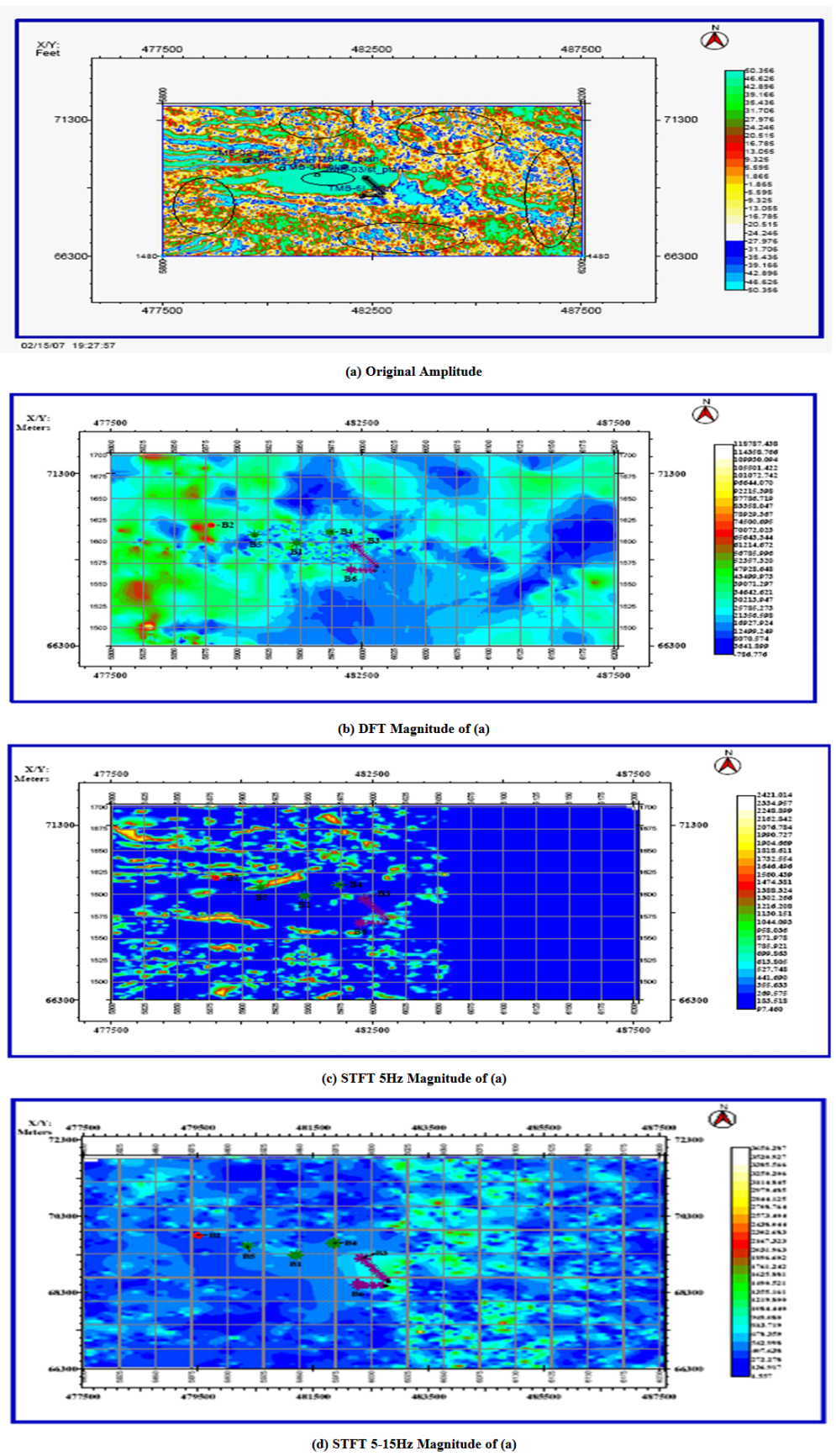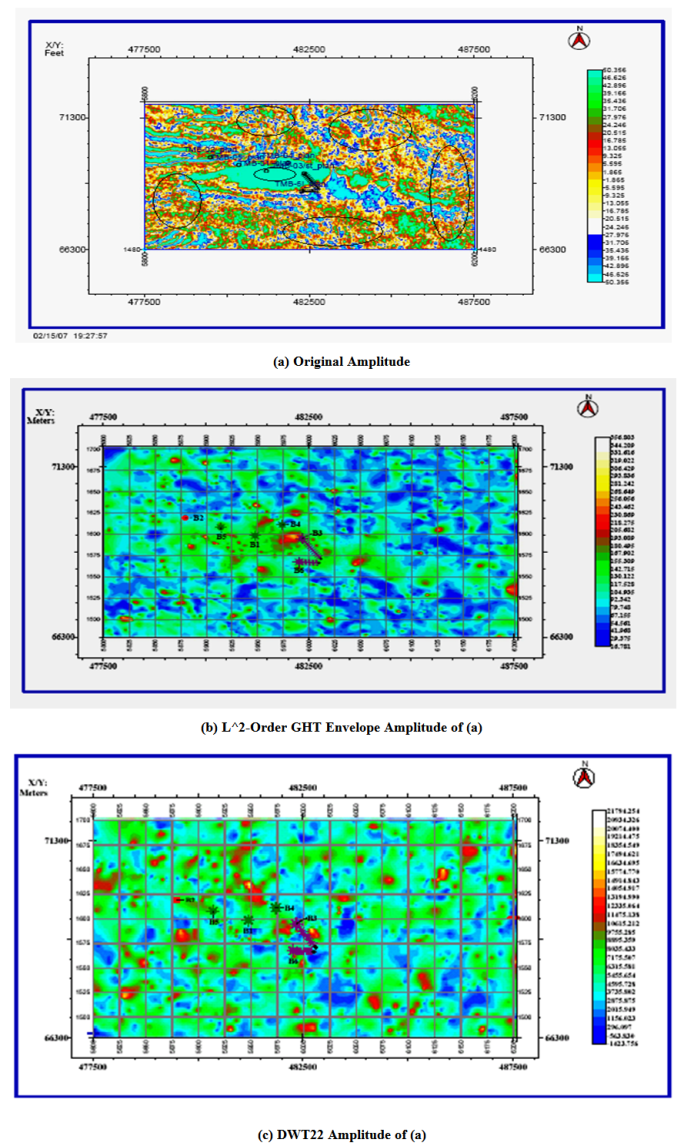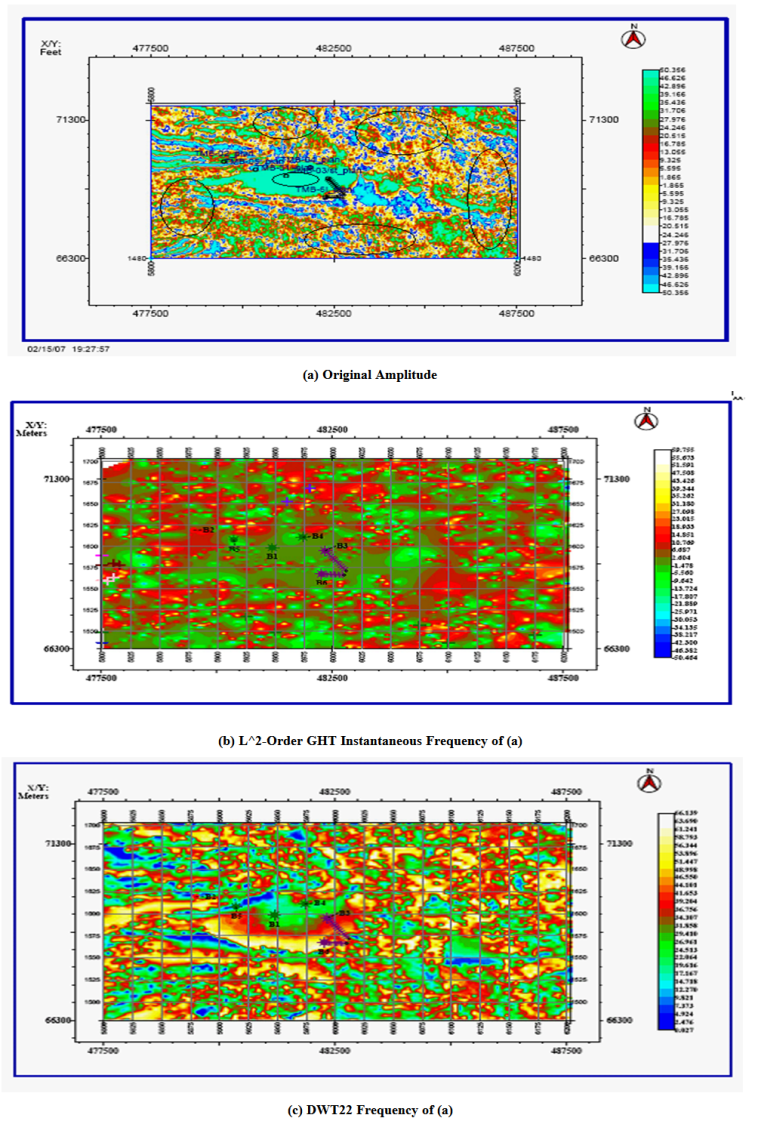-
Paper Information
- Next Paper
- Paper Submission
-
Journal Information
- About This Journal
- Editorial Board
- Current Issue
- Archive
- Author Guidelines
- Contact Us
Geosciences
p-ISSN: 2163-1697 e-ISSN: 2163-1719
2015; 5(3): 86-99
doi:10.5923/j.geo.20150503.02
The Application of Spectral Decomposition to 3-D Seismic Data over ‘X’-Oil Field, Niger Delta
Williams Ofuyah1, Omafume Orji2, Stanley Eze1
1Department of Earth Sciences, Federal University of Petroleum Resources, Effurun, Nigeria
2Department of Petroleum Engineering and Geoscience, Petroleum Training Institue, Effurun, Nigeria
Correspondence to: Williams Ofuyah, Department of Earth Sciences, Federal University of Petroleum Resources, Effurun, Nigeria.
| Email: |  |
Copyright © 2015 Scientific & Academic Publishing. All Rights Reserved.
Classicseismicinterpretation involves direct fault and horizon mapping, sequence stratigraphy and seismic modeling to produce structural, stratigraphic and reservoir maps for the delineation, exploration and production of hydrocarbon in oil and gas fields. The first two methods operate on stacked and migrated data, while the third is done without adequate calibration. These result in interpretational ambiguities because of poor resolution of the seismic wavelength, inadequate display of final stacks and coarse processing. Actual hydrocarbon entrapments are rarely detailed well enough to permit reliable location of wells from these studies alone. This paper presents the results of the application of spectral decomposition to 3-D seismic data over ‘X’-field, Niger Delta. Traditionally, spectral decomposition includes various techniques that require the use of a time window {e.g. Discrete Fourier transform (DFT), Maximum Entropy, Hilbert transform (HT), etc}. The resultant limitations of vertical resolution, spectral smearing, and weak frequency discrimination attributable to the applied window have led to the need to search for improved techniques. We have applied the Generalized Hilbert Transform (GHT) and Discrete Wavelet Transform (DWT) in the interpretation of 3-D seismic data. The GHT extends the HT by introducing a window and an order. Hilbert transform is of order one and one of the possible orders of implementation for the GHT. DWT uses a variable window and gives better resolution than the short-time Fourier transform with fixed window size. Our algorithm is based on Fast Fourier Transform (FFT) convolution technique and was developed from first principles and outside oil-industry interpretational platforms using standard processing programs such as Matlab, etc. The results of the spectral decomposition yielded frequency maps that revealed subtle sub-seismic faults, differences in lithology, and reliable amplitude/petrophysical parameter transforms. By revealing by-passed reservoirs and better delimiting reservoirs, more hydrocarbons will be recovered and field development will be enhanced.
Keywords: Hilbert Transform Fourier Transform, Discrete Wavelet Transform, Convolution
Cite this paper: Williams Ofuyah, Omafume Orji, Stanley Eze, The Application of Spectral Decomposition to 3-D Seismic Data over ‘X’-Oil Field, Niger Delta, Geosciences, Vol. 5 No. 3, 2015, pp. 86-99. doi: 10.5923/j.geo.20150503.02.
Article Outline
1. Introduction
- Spectral decomposition of a time series involves the determination of the frequency spectrum of the series for each time sample. This is desirable in the identification and characterization of transient features characterized by unknown locations and time extents. Such features constitute stratigraphic anomalies in a dense data volume, as in 3D seismic, which may not necessarily be obtained from a geologically complex hydrocarbon habitat. By decomposing such signal into elementary building blocks that are well localized in time, frequency, and space, it is possible to reliably characterize its local regularity using high resolution spectral techniques.This paper presents the results of the application of spectral decomposition to 3-D seismic data over ‘X’-field, Niger Delta. Traditionally, spectral decomposition includes various techniques that require the use of a time window {e.g. Fast Fourier transform (FFT), Discrete Fourier transform (DFT), maximum Entropy, Hilbert transform (HT), etc}. The resultant limitations of vertical resolution, spectral smearing, and weak frequency discrimination attributable to the applied window have led to the need to search for improved techniques.Recent research results indicate that accurate spectral localizations and reflections capable of delimiting and delineating direct, surface wave and artifact energy that constitute noise, in this context, can be obtained from wavelet based decompositions. [1].Some applications of spectral decomposition techniques are given in “Interpretational applications of Spectral decomposition in reservoir characterization”. [2]. Frequency- Time decomposition of seismic data using wavelet-based. [3] and complex seismic trace analysis of thin beds. [4], [5] initiated a technique for computing thickness in thin bed analysis. However, the literature on the use of high resolution spectral techniques in solving seismic signal problems is limited because it has not been well addressed and documented. Accurate knowledge of facies compartment and distribution, pressure regimes, fluid content and migration path for fluid are needed for flow models for optimal hydrocarbon recovery. We have applied the Generalized Hilbert Transform (GHT) and Discrete Wavelet Transform (DWT) in the interpretation of 3-D seismic data obtained from the Niger Delta. The GHT extends the HT by introducing a window and an order. Hilbert transform is of order one and one of the possible orders of implementation of the GHT. The DWT is defined as an analysis filter, and it is an alternative to the STFT. The discrete wavelet transform uses a variable window and gives a better resolution than the Short-time Fourier transform with fixed window size. The standard Seismic data and interpretation techniques do not resolve low amplitude anomalies in thin bed situation. We investigated, in a comprehensive manner, the weaknesses of the conventional interpretation techniques in frequency domain (spectral decomposition), and in the characterization of thin sand hydrocarbon reservoir in relation to the improvement obtained from the algorithm we developed. A thin bed, based on reflective properties, is one whose thickness is less than about one eight of the (predominant) wavelength computed using the velocity of the bed. [5]. Enhanced time domain interpretation technique was also examined.The central result of this analysis is the development and implementation of a flexible and optimal work flow interpretation algorithm. Our algorithm is based on Fast Fourier Transform (FFT) convolution technique and was developed from first principles and outside oil-industry interpretational platforms using standard processing programs such as Matlab, Pascal, etc. The results of the algorithm, when implemented on both oil-industry (e.g. Kingdom Suite) and general platforms, were comparable and convincing. In this work, the HT and structure maps only were computed with the Kingdom Suite Software. Spectral decomposition of the 3D data yielded frequency maps that revealed subtle sub-seismic faults, differences in lithology, and reliable amplitude/petrophysical parameter transforms. The practical relevance of our analysis was demonstrated by means of maps, pseudo-sections and cross plots. By revealing by-passed reservoirs and better delimiting reservoirs, a convincing image of the architecture of the Miocene-age reservoir which will facilitate the recovery of more hydrocarbons and field development, was obtained. This work has successfully characterized a Miocene-age thin reservoir in the area of study. Geological Setting The source of our data is the Niger delta region of which the ‘X’ –basin is a part. It is a prolific hydrocarbon province formed during three depositional cycles from middle cretaceous to recent in Nigeria. The recent Niger Delta has the continental, transitional and marine environments comprising braided streams, meander-belt systems, floodplain basins, barrier bars, fire sand, silt and clay. Most of the hydrocarbons are in the sandstones of the Agbada formation, mostly trapped in roll over Anticline, fronting growth faults. The shales create lateral and top seals. [6]. The reservoirs of this formation are typically channels and barrier sandstone bodies and values of porosity and permeability are generally high (up to 40% and 1-2 darcys respectively).
2. Theory of Seismic Signal Transforms
- Discrete Fourier Transform The Discrete Fourier transform (DFT) is the digital equivalent of the continuous Fourier transform and is expressed as
 | (2.1) |
 | (2.2) |
 | (2.3) |
 | (2.4) |
 are the amplitude and phase spectra respectively. [7].The weaknesses of the DFT e.g spectral smearing can be improved by the application of short time former transform (STFT). Short-Time Fourier TransformThe Short-time Fourier transform (STFT) or windowed Fourier transform is an analysis with fixed resolution. It maps a seismogram into a 2-D frequency-time plane.It is motivated by the need for a spectral representation that incorporates the time-varying properties of a non-stationary signal. Assuming the signal f(t) (time-domain seismogram) is stationary when seen through a window g(t) of limited extent, centered at time location (T), then the STFT can be expressed as follows:
are the amplitude and phase spectra respectively. [7].The weaknesses of the DFT e.g spectral smearing can be improved by the application of short time former transform (STFT). Short-Time Fourier TransformThe Short-time Fourier transform (STFT) or windowed Fourier transform is an analysis with fixed resolution. It maps a seismogram into a 2-D frequency-time plane.It is motivated by the need for a spectral representation that incorporates the time-varying properties of a non-stationary signal. Assuming the signal f(t) (time-domain seismogram) is stationary when seen through a window g(t) of limited extent, centered at time location (T), then the STFT can be expressed as follows: | (2.5) |
 | (2.6) |
 | (2.7) |
 | (2.8) |
3. Method
- Geologic discontinuities such as faults and fractures in 3-D seismic data manifest themselves as abrupt, gradual, and gentle changes of amplitudes. The techniques for identifying abrupt and gradual changes have been provided by many authors including [13] (Coherence Cube), [2] (Spectral decomposition). In order to detect these changes, we adopted spectral analysis using HT, STFT, GHT and DWT.In the spectral domain, we employed the fast Fourier convolution techniques (FFT), a Gaussian window function, second order (n = 2) for GHT analysis and scale-translation parameters (a, b) of (2, 2) for DWT computation.The conventional transforms were first applied to a thin–sand reservoir of thickness 16ms embedded in a data cube. Having known the strengths and weaknesses of the conventional spectral techniques, they were then extended..The DFT was extended to the STFT, the HT to GHT, while the STFT was extended to the DWT, in order to overcome their limitations while retaining their desirable characteristics. The entire techniques (Conventional and developed) were applied to the thin-sand reservoir and the outputs compared. As a result of the comparative analysis involving several informative attributes of the transforms undertaken, we present only the maps of the top of the reservoir (Figures 1-8).An interpretational work flow algorithm external to oil industry software was developed and implemented on the 3D data set. Only the original and HT maps were computed within the Kingdom suite software. Other maps were computed with the developed algorithm in Matlab software.The outputs were displayed on both general and Oil industry (kingdom Suite, version 6.7, SMT) software and compared. The enhanced definition of the geologic discontinuities is evident and self explanatory on the maps obtained from the improved techniques. We mapped the zone of interest and interpreted it with the Kingdom Suite software from the outset. The entire 3D was interpreted afterwards. Wells 01, 04 and 05 were adopted as representative wells for interpretation in view of their good data quality.
4. Results
- The result obtained when the entire transforms comprising the conventional and developed ones were applied to the thin sand in the 3-D data are shown in Figures 1-8. The results are presented in comparative terms and with reference to original data. This is because GHT is an extension of HT, while DWT is an alternative to STFT, which in turn extends the DFT.
 | Figure 6. ‘X’-Field, Niger Delta: (a) Original Amplitude (b) L^2-Order GHT Instantaneous Phase (c) DWT22 Phase of .Fault delineation is distinct in DWT22. There is clear cut phase segmentation in (c) |
 | Figure 8. ‘X’-Field, Niger Delta, (Sand C1, Top, 2.752 Secs.. 3D): (a) Original Amplitude (b) STFT 5-15Hz magnitude of (a). (c) L^2-Order GHT Envelope Amplitude of (a). (d) DWT22 Amplitude of (a) |
5. Discussion of Results
- The magnitude display in Figure 3 indicates that the STFT map at tuning amplitude (5-15Hz) is better than that of mono-frequency of 5Hz while the DFT magnitude is smeared. The bases of well 03 and 06, for instance, are not distinctly located in channel on DFT, but distinguished on the STFT maps, particularly the STFT (5-15Hz) (resonant amplitude band). The DFT and STFT maps indicate that well 02, 03 and 06 are located on shale. On the original map, well 02 and the top of wells 03 and 06 are shown to be on sand and well 05 in channel. Wells 01, 04 and 05 are properly located on sand and is reflected in their good data quality. However the DWT2,2 phase (Figure 6) indicates clearer images as it shows convergent phase ridges, the highs (White) and the lows (Red and Green) axes. This contrasts with the zeroing due to small phase values as in Fourier maps.The frequency map of DWT2,2 (Figure 7) shows that translated wavelet (DWT2,2 ) gives better image. The channel paths (Blue) are within a bandwidth of 0-27Hz. This is consistent with the frequency spectrum in Figure 2. The useful frequency band of the DFT (0-65Hz) is smeared. That of the STFT (0-40Hz) is also smeared but better than that of DFT. The useful bandwidth of the DWT is 0-25Hz. The bandwidth is also 0-22Hz (Green) for the arbitrary map (HT instantaneous frequency, not shown). This reinforces the deduction that the DWT attribute maps are superior to the DFT and STFT, and closest to the hard data (Figure 4).In figure 18, the GHT amplitude map gives better definition of the stratigraphy than on both the original and HT amplitude maps.On the GHT instantaneous frequency map in Figure 7, it can be seen that the accurately located wells (01, 04, and 05) are sited where frequency values are within 0-25Hz (Green) on the map. This is consistent with the DWT bandwidth. New prospective zones can be inferred from the Green locations on the GHT map.The superiority of the DWT2,2 frequency can be seen in Figure 7 and the useful frequency limit is 27Hz. The integrated display of the amplitudes map of original, STFT, GHT and DWT is shown in Figure 8. The GHT envelope and DWT2,2 maps give enhanced images of the top amplitude in most respects. Other distinguishing events such as channel patterns are clearer on the DWT than on any of the Fourier techniques.
6. Summary and Conclusions
- We have investigated five different spectral decomposition techniques that use seismic data for the characterization of thin-sand reservoir. Our aim was to develop a practical method for mapping stratigraphy which is usually masked after normal data interpretation.Seismic data obtained from the Niger Delta were analyzed using the DFT, HT, STFT, GHT and DWT. By comparing the features on the HT, DFT, STFT and those seen on the GHT and DWT with respect to noise level, such sensitivity becomes evident for the conventional techniques, whereas the GHT and DWT techniques images are stable and clearer. Poor interpretation results in wrong well location, reservoir by-pass and hence slow field development.Each attribute from the algorithm provides new and different but convergent information all of which, when integrated, aid in well planning location and field development.We established that reservoir is compartmentalized into two parts, and that the reservoir is of the channel type, typical of many reservoirs in the Niger Delta. In addition we deduced a negative relief (beyond well 0.2 and) and a positive one (beyond wells 03 and 06) indicating a depression or valley. The wells are located at the banks of the channels and there is heavy faulting at line 5840 (corresponding to the negative relief) and at line 6100 (positive slope).We conclude that joint GHT and DWT analysis of seismic data in combination with the classical STFT can be a powerful practical tool to quantitatively map reservoir architecture. This is crucial in complex geological settings such as geological edges and reflection-free hydrocarbon habitats.Our algorithm is flexible and relatively inexpensive and was developed from first principles and outside standard oil-industry interpretational platforms but using standard processing routines. We implemented it on both standard and general platforms and found the match, on comparison to be convincing.This technology has successfully characterized the thin- sand reservoir and delineated other stratigraphic and structural settings in the area of study.
ACKNOWLEDGEMENTS
- We thank Chevron Corporation, Nigeria for making the seismic and well data available for use. We are also indebted to Shell Nigeria for the use of the Kingdom Suite Software at its work station at Department of Geology, Obafemi Awolowo University (O.A.U.), Ile-Ife, Nigeria and to the Federal University of Petroleum Resources, Effurun, Nigeria for the use of her computing facilities.
 Abstract
Abstract Reference
Reference Full-Text PDF
Full-Text PDF Full-text HTML
Full-text HTML




